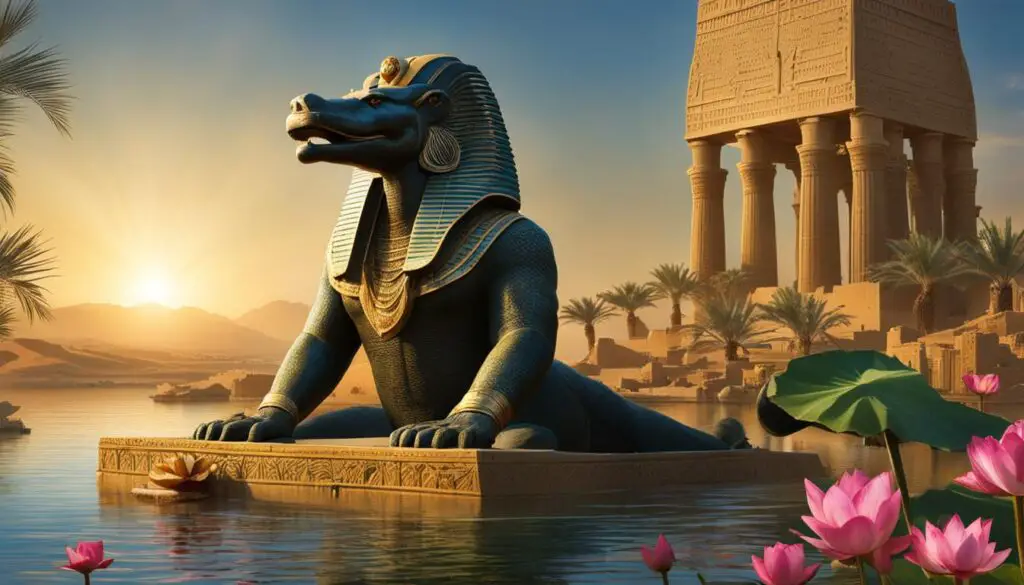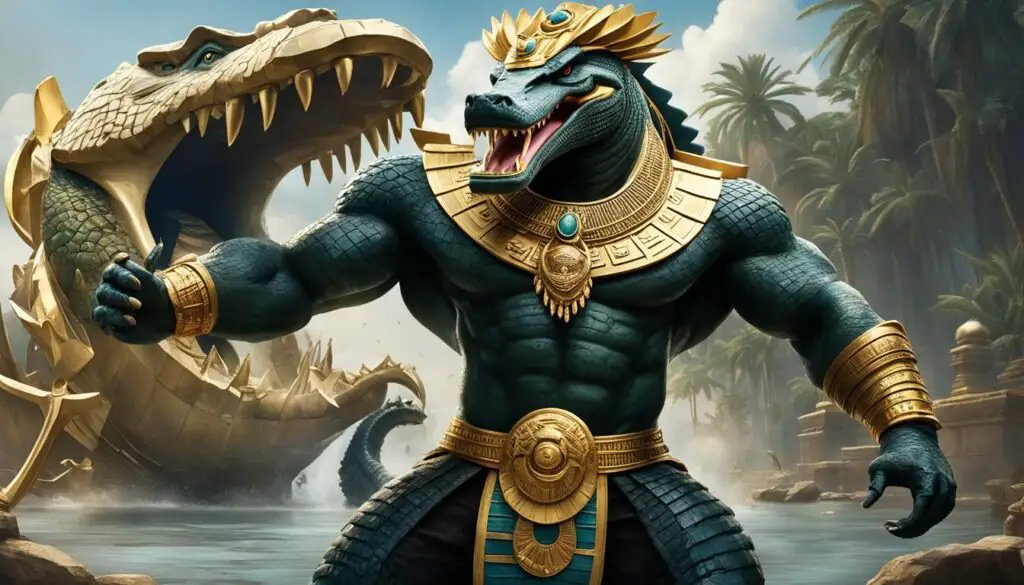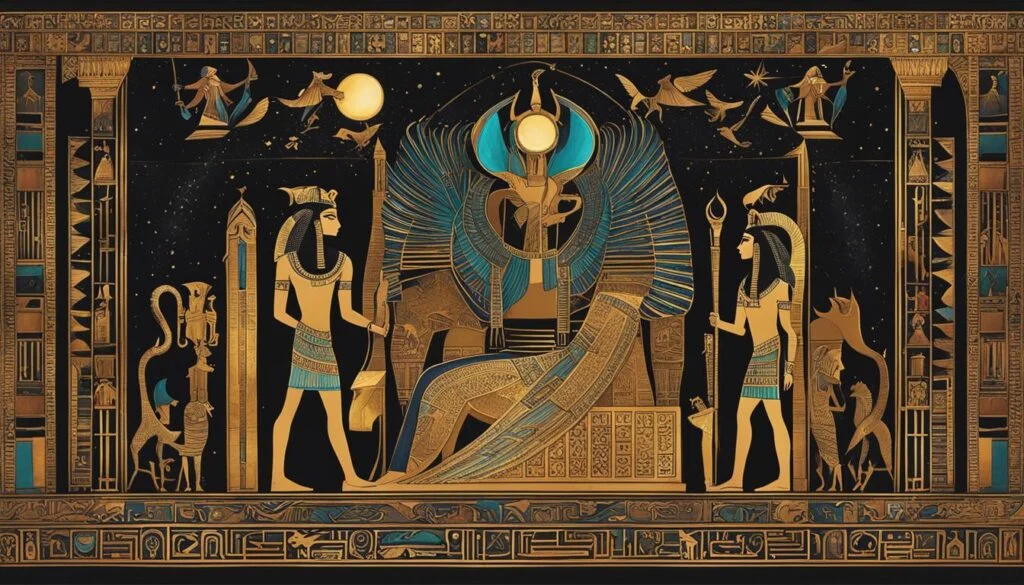Welcome to our exploration of ancient Egyptian mythology, where we delve into the fascinating world of gods and goddesses. In this article, we will unveil the captivating deity known as Sobek, the Egyptian crocodile god. If you have ever wondered which Egyptian god is associated with crocodiles, you are about to uncover the intriguing tales of Sobek and his divine significance in ancient Egypt.
Key Takeaways:
- Sobek, the Egyptian crocodile god, was a major deity in ancient Egypt.
- Depicted with the head of a crocodile and a crown composed of ram horns, a sun disk, and feathered plumes.
- Sobek was associated with fertility, pharaonic power, and protection against the dangers of the Nile.
- His worship centers included Faiyum, Crocodilopolis, and Kom Ombo.
- Sobek’s popularity spanned from the Old Kingdom to the Roman period, and he was praised by the first female Pharaoh, Sobekneferu.
The History of Sobek
Sobek, the ancient Egyptian god associated with crocodiles, has a rich history that dates back to the Old Kingdom. He is mentioned in the Pyramid Texts, where he is praised as the living incarnation of the crocodile god.
The name “Sobek” is derived from the Egyptian word “Sbk,” which is believed to be connected to the verb “to impregnate.” This suggests Sobek’s association with fertility and his role in the Nile’s annual flooding, which brought life-giving nutrients to the land.
During the Middle Kingdom, particularly under the reign of Amenemhat III, Sobek’s cult gained prominence. It was during this period that Sobek underwent a significant transformation. He was fused with the falcon-headed god Horus, symbolizing the connection between Sobek and pharaonic power and kingship.
The Fusion of Sobek and Horus
The fusion of Sobek and Horus solidified Sobek’s position as a powerful guardian and protector of the pharaohs. This association with pharaohs further elevated Sobek’s status within Egyptian society.
As Sobek’s influence grew, so did his connections to other deities. In later periods, Sobek became associated with the sun god Ra, adopting the name Sobek-Ra. This further expanded Sobek’s association with cosmic power and divine authority.
The image above depicts the mighty Sobek, with the head of a crocodile, showcasing his iconic imagery as one of the ancient Egyptian crocodile deities.
As the god of fertility, pharaonic power, and divine protection, Sobek held a significant place in the hearts and minds of ancient Egyptians. His history and associations reveal insights into the beliefs and culture of ancient Egypt.
Cult Centers and Worship of Sobek

The cult of Sobek, the Egyptian god of the Nile and crocodiles, was centered in the Faiyum region of Egypt, particularly in the city of Shedet, also known as Crocodilopolis. As the main cult center dedicated to Sobek, Shedet held great significance in the worship of this crocodile deity. The Faiyum region itself was referred to as the “Land of the Lake,” named after Lake Moeris, a prominent feature of the area.
Sobek’s worship extended beyond Shedet, as his popularity spread to other towns and cities in Egypt. Each locality developed its own unique variations and interpretations of the god, showcasing the diverse ways in which Sobek was revered throughout the country.
Temples dedicated to Sobek were constructed not only in Shedet but also in other significant locations like Kom Ombo, demonstrating the widespread devotion to this powerful deity. These temples served as focal points for religious ceremonies and rituals dedicated to Sobek.
Worship of Sobek played a crucial role in ancient Egyptian society. The people of Egypt attributed their prosperity and the fertility of their lands to Sobek, seeking his blessings for abundance in both people and crops. Mummified crocodiles, believed to be the sacred creatures associated with Sobek, were often included in Egyptian tombs as a symbol of protection and divine favor.
Sobek’s Character and Mythologies

Sobek, the Egyptian god depicted as a crocodile, embodies the ferocious and animalistic qualities associated with these mighty creatures. His depictions showcase a majestic deity with sharp teeth, known as a robber and even a creature who eats while mating. However, Sobek’s character is multifaceted, and he displays benevolent qualities in certain myths.
One of Sobek’s notable qualities is his association with healing. In Egyptian mythology, Sobek played a role in the story of Osiris, the god of the afterlife. It is said that Sobek helped in reassembling Osiris’s dismembered body, contributing to his resurrection and symbolizing the regenerative power of the Nile. This association with healing reinforces Sobek’s position as a deity with complex traits.
Sobek’s significance extends beyond healing and his role in the Osiris myth. He is also considered a creator god, rising from the primeval waters to shape the rest of the gods and the world. This portrayal establishes Sobek’s importance in the Egyptian pantheon as a deity associated with creation and divine power.
Furthermore, Sobek has a strong association with divine kingship, making him a significant figure in Egyptian mythology. The crocodile god’s role as a protector of the pharaoh and the people further establishes his power and influence. Sobek’s presence is believed to provide safety and guard against the dangers of the Nile, highlighting his role as a guardian deity in ancient Egyptian culture.
In summary, Sobek, the crocodile god in Egyptian mythology, embodies both the fierce and benevolent aspects of crocodiles. His character showcases complex traits, encompassing healing abilities, a role in creation, and association with divine kingship. Sobek’s portrayal as a protector highlights his significance in ancient Egyptian culture and mythology.
Conclusion
Sobek, the Egyptian crocodile god, played a significant role in the religious beliefs and mythology of ancient Egypt. Revered for his connection to fertility, pharaonic power, and protection, Sobek was worshiped in various cult centers throughout Egypt. His fusion with the gods Horus and Ra further emphasized his importance within the Egyptian pantheon. By worshiping Sobek, the Egyptians demonstrated their deep reverence for nature and the Nile, as Sobek embodied both the ferocity and fertility of the natural world. The myths and cults surrounding Sobek provide valuable insights into the religious practices and beliefs of ancient Egypt.
FAQ
Who is Sobek?
Sobek is the Egyptian god associated with crocodiles. He was a major deity in ancient Egypt and was depicted with the head of a crocodile. Sobek was worshiped for his association with fertility, pharaonic power, and protection.
What is the significance of Sobek in ancient Egyptian mythology?
Sobek held a prominent place in ancient Egyptian religion and mythology. He was believed to be the son of Set/Khnum and Neith and was often associated with fertility and the Nile. Sobek was also revered as a protective deity, invoked for protection against the dangers presented by the Nile.
Where were the cult centers of Sobek located?
Sobek was worshiped in various cult centers across Egypt. The main cult center of Sobek was Shedet (Crocodilopolis) in the Faiyum region. Other cult centers included Faiyum, Crocodilopolis, and Kom Ombo. Each town developed its own localized versions of the god.
How is Sobek depicted in Egyptian mythology?
Sobek is often depicted as a ferocious and animalistic deity with the head of a crocodile. His epithets describe him as a robber, a creature who eats while mating, and one with pointed teeth. However, Sobek also displayed benevolent qualities in certain myths, particularly in his association with healing and his role in the story of Osiris.
What can we learn from the worship of Sobek?
The worship of Sobek demonstrates the importance of nature and the Nile in ancient Egyptian culture. As the crocodile god, Sobek represented both the ferocity and fertility of the natural world. His myths and cults provide valuable insights into the religious beliefs of ancient Egypt.




